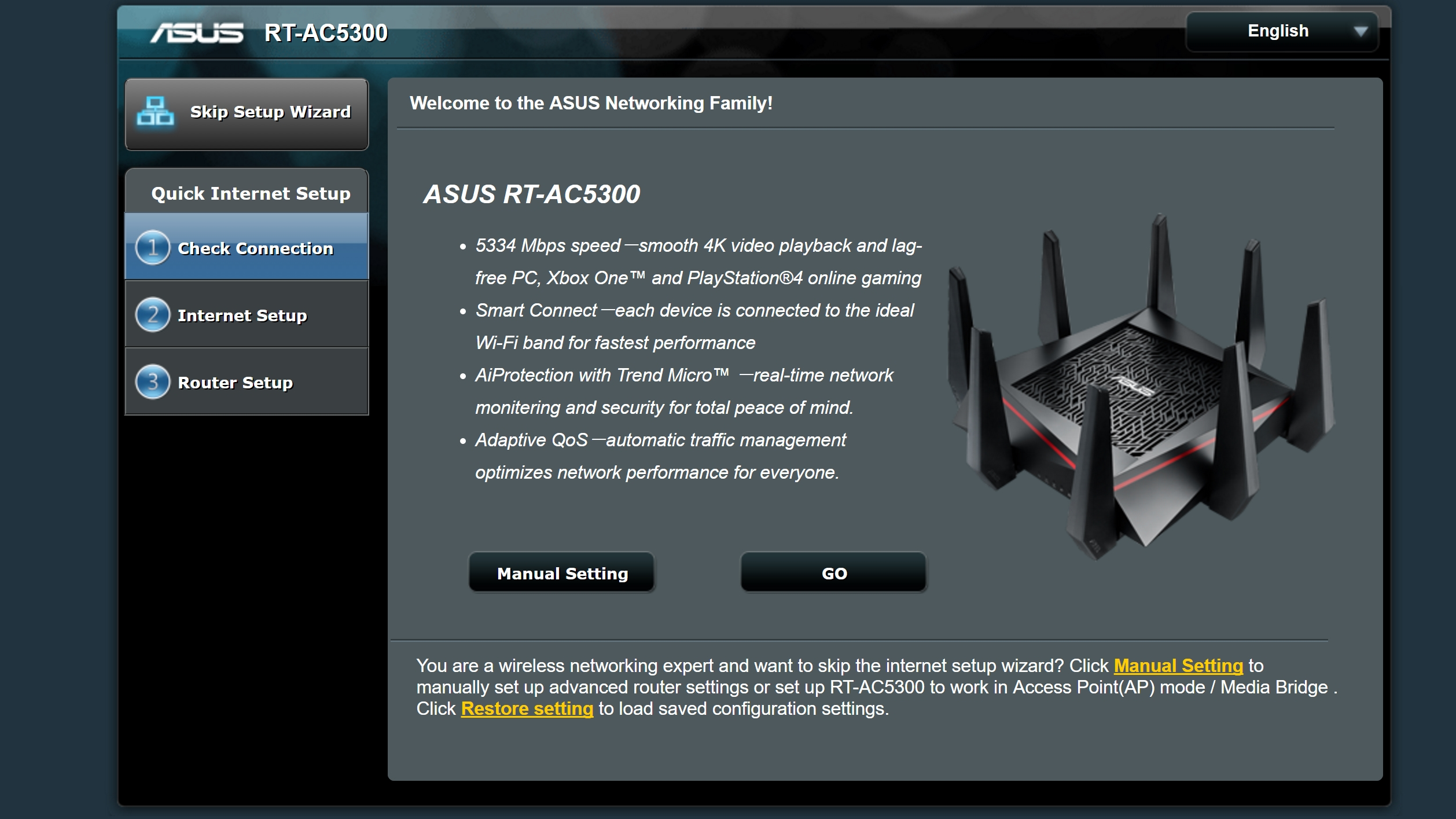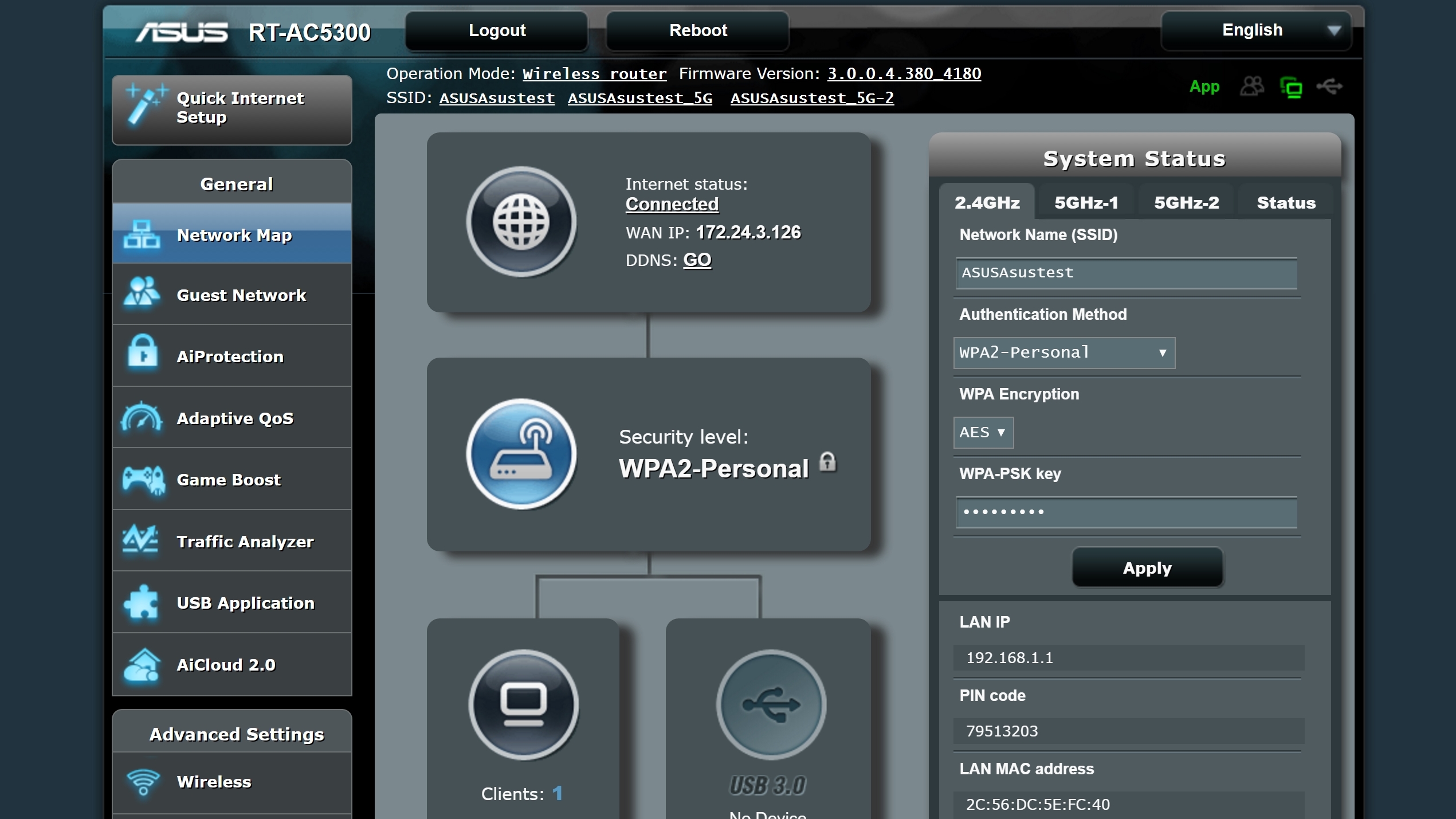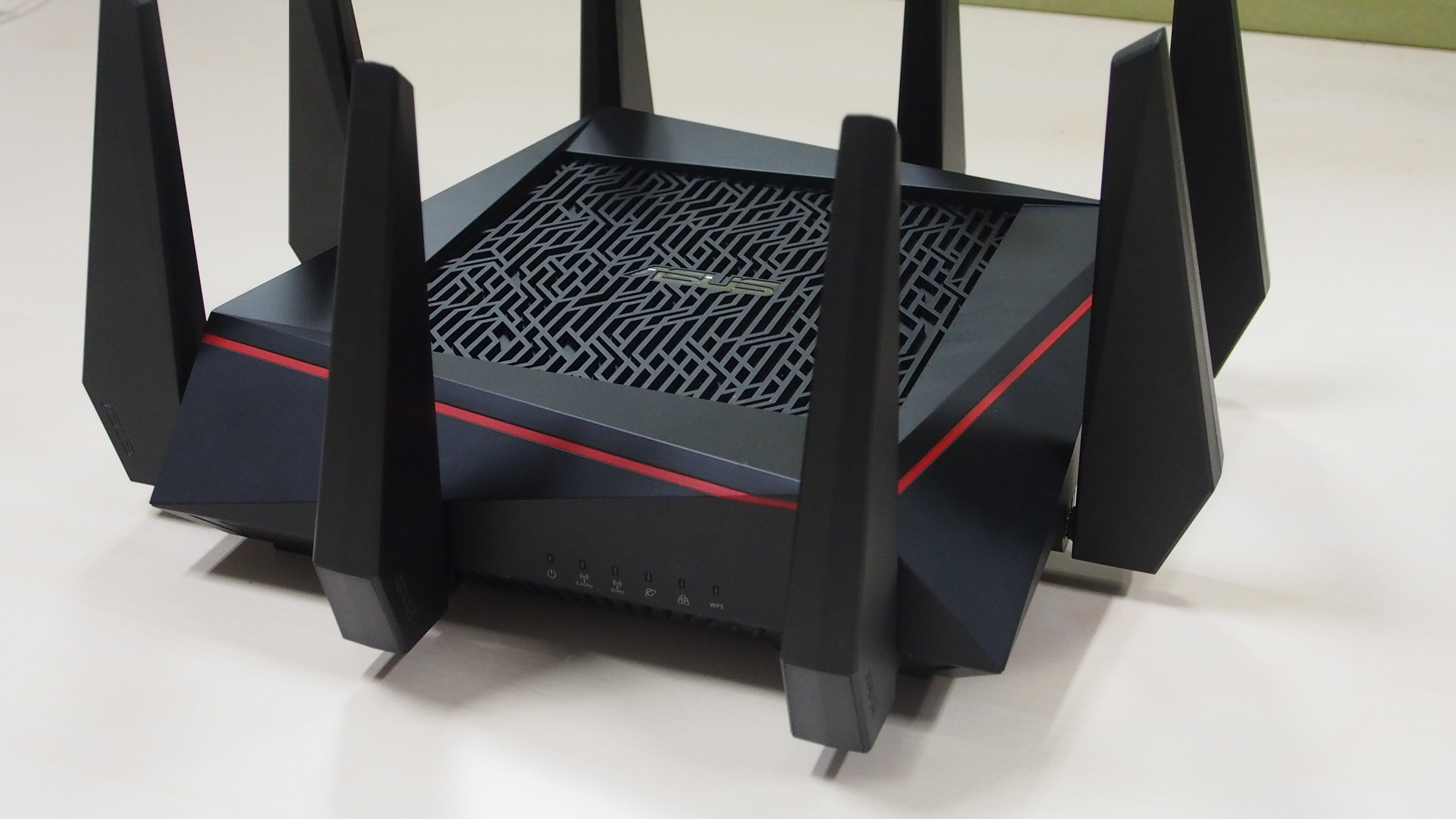TechRadar Verdict
This is a supremely fast and powerful router that will broadcast Wi-Fi to all corners of even the largest house or office – but its focus on gamers and media streaming may put people off.
Pros
- +
Very fast
- +
Strong Wi-Fi coverage
- +
Link aggregation for 2Gbps speeds
- +
Easy setup
Cons
- -
Expensive
- -
Only one USB 3.0 port
- -
Design isn't for everyone
- -
USB speeds disappointing
Why you can trust TechRadar
Without even opening the box you can tell that the Asus RT-AC5300 Tri-band Gigabit Router is aimed more at gamers than home office, professional and enterprise users. This isn’t an unobtrusive beige box that quietly and competently controls your network. Instead it has a bold and brash design that is either striking or horribly garish, depending on your personal preference.
It’s a large router with eight bulky antennas that make it look like an upturned spider straight from Darth Vader’s nightmares. You can wall mount it – not that you’d particularly want to – or hide it away and hope the strength of its tri-band networks can still reach all of your devices.
However, just because this is a router that’s aimed at gamers and those of us who love to stream movies and music, should it be overlooked by pro users? Not necessarily, as Asus has crammed some impressive specs into the RT-AC5300, and its promise of ‘fast, easy, stable’ performance will surely appeal to many network administrators.
However, at £382 ($360, around AU$490), this is a very expensive router, so you’ll want to make sure that the features and specifications of this device align with your needs before putting that kind of money down. If it doesn’t, then your money will be better spent on a more straightforward, business-orientated, router.

Features
For a router with this sort of price tag, you’d expect a long list of features, and in that regard the Asus RT-AC5300 Tri-band Gigabit Router certainly doesn’t disappoint. The headline feature (as it’s included in the name) is that the RT-AC5300 broadcasts three wireless bands, where most other routers stick to two.
That means you get one 2.4GHz band at 1000 Mbps for older legacy devices, along with two 5GHz bands at 2167Mbps 802.11ac. The idea with multiple bands is that you can have older devices on the 2.4GHz band, freeing up 5GHz bands for new devices.
Now that there is an ever increasing number of 5GHz-capable devices, the 5GHz band can become crowded, with more traffic resulting in slower – or less reliable – connections.
Sign up to the TechRadar Pro newsletter to get all the top news, opinion, features and guidance your business needs to succeed!
This is there the second 5GHz band comes in, helping to spread the traffic, with the second band focused on gaming and 4K media streaming. Of course, in an enterprise situation, gaming and 4K streaming isn’t an issue, but you can still make use of these three separate wireless networks in a home office or enterprise setting, and the eight large antennas, which gives the Asus RT-AC5300 such a distinctive look, are there to help beam the networks around a building. These can be adjusted to point in various directions, helping to boost network coverage.
It comes with a 1.4GHz dual-core processor from Broadcom and 512MB of RAM. Other features include WPA-Enterprise and WAP2-Enterprise encryption, MU-MIMO, adaptive QoS (remember this is a router primarily geared at gamers, so gaming and media traffic can be given higher priority), guest network functionality, VPN servers, 3G and 4G data sharing and link aggregation, which combines multiple network connections to increase throughput.
It comes with five Gigabit Ethernet ports – however as this is a router only, and not a modem, it means that one of these ports is a dedicated WAN port for connecting up to your existing modem. It would have been nice for a modem to have been built in as well, reducing the number of boxes you need to be plugged in, but it does give the Asus RT-AC5300 a bit more flexibility as well. It also comes with one USB 2.0 and one USB 3.0 ports as well.
This is by no means an exhaustive list of the Asus RT-AC5300’s features – listing them all here would be too time consuming, but you can be assured that for your money you are getting an incredibly robust and feature-rich router.
Performance
The installation process for the Asus RT-AC5300 is fast and straightforward. All we had to do was plug it in, then connect our laptop to the open Asus network that we discovered. Connecting to this opens up your web browser and takes you straight to the Quick Internet Setup wizard, which takes you through the process of checking you connection and configuring your internet.

If you want complete control of the setup process, there’s a manual mode as well which gives you the opportunity to add or remove features. This is handy if you want to turn off some of the more gaming and streaming-orientated features. Otherwise, the Quick Internet Setup wizard does a good job of quickly configuring the router for your network, creating the three new wireless networks and applying security measures to them.
Once that’s been set up you can easily access the router’s settings interface by typing in router.asus.com – which means no more having to try and remember an IP address.
This user interface is easy to understand and gives you all the information you need to know about your network. I was very pleasantly surprised with the interface, as in the past I’ve encountered router software that has been drab, clunky and sometimes overly complex, but here it is presented stylishly without being overly flamboyant (a worry with some gaming-orientated devices that try too hard to be stylish). You can’t install your own firmware, such as OpenWRT, so you’ll never quite get full control over your router, which may be an issue for some network admins.

To test out the range of the Wi-Fi we first used the Broadband Speed Checker tool to measure our download speeds with our device next to the Asus RT-AC5300 using one of the 5GHz networks.
It recorded 151.19Mb/s. We moved to the room next door in our large office, and the results was a still impressive 134.2Mb/s. To really test the range we then went through another two sets of doors, and tried it again. This time the speeds dropped to 55.81Mb/s. While this is quite a significant drop, we were now standing around 60 feet away from the router, with a number of doors and walls between us.
With a bit of tweaking of the antennas so that they pointed in our direction, we managed to boost the speeds up to 68.24MB/s. While still a drop, these are still perfectly acceptable speeds. Finally we went to the floor below and stood roughly beneath the Asus RT-AC5300. There, we recorded speeds of 140.26MB/s.
What these tests demonstrated was that the Asus RT-AC5300 offers excellent Wi-Fi coverage, so even in large homes and offices you should still be able to connect your devices for decent data transfer speeds.
The USB 3.0 port allows for hard drives and USB sticks to be shared across the network. This is easy to set up, but don’t go expecting speeds similar to a dedicated NAS – the results were a rather disappointing 38MB/s read, 40MB/s write.

Matt is TechRadar's Managing Editor for Core Tech, looking after computing and mobile technology. Having written for a number of publications such as PC Plus, PC Format, T3 and Linux Format, there's no aspect of technology that Matt isn't passionate about, especially computing and PC gaming. He’s personally reviewed and used most of the laptops in our best laptops guide - and since joining TechRadar in 2014, he's reviewed over 250 laptops and computing accessories personally.
